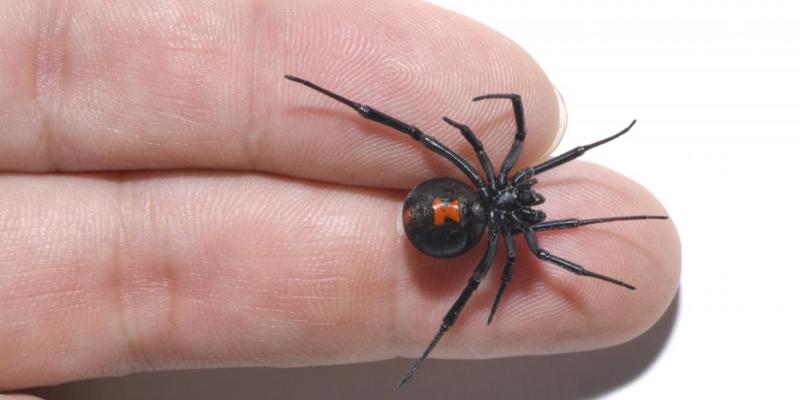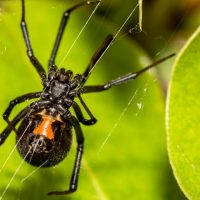
The creepy-crawly, eight-legged things can be scary to see around your house, but the majority of spiders play a vital role in our ecosystem at controlling other pests. As hard as it is to imagine, keeping them alive could make our lives easier, even if our minds are a little uneasy for the next few minutes.
However, there are a few spiders that you may want to keep an eye out for that aren’t welcome in your home as they pose a threat to you and your family. A black widow is one of these exceptions in this case as they are dangerous creatures that could cause harm to anything it encounters. Knowing the basics about black widows could better prepare you in avoiding their habitats, but also eliminating potential habitats throughout your home.
What Does a Black Widow Spider Look Like?
Black widows get their name for their signature jet black color and the fact that some females have been thought to eat males after mating. Male black widows are just black, but you can tell female black widows apart from other black spiders by the notorious red hourglass on the underside of their abdomen. Female black widows are the ones to be worried about because males don’t have the toxins that females that cause harm.
Do Black Widows Bite?
Many people believe black widows are aggressive and will bite you for no reason. In reality, most black widows are only aggressive when you get near the webs that have an egg sac on them. In most instances, they have to be pressed against flesh to be instigated enough to bite. This happens many times when searching through dark corners that black widows may be hiding or walking in a garden without the proper attire. Black widows are shy nocturnal arachnids, so many times if you are bitten outside, then you have walked into their territory.
How to Prevent a Black Widow Bite

Black widows are normally found outside, so when working in the garden or yard, be sure to wear gloves, long sleeves, and closed-toed shoes. Your clothing is your first line of defense and could be the factor that keeps you from being bitten as black widows usually only bite once.
Be vigilant when going into an area that you haven’t been in a while or can’t see well, because there may just be something else living there. Black widows may even crawl into shoes or gloves that aren’t used often, so it is a good idea to shake them out to make sure there isn’t a guest hiding in there.
What Happens if You’re Bit by a Black Widow Spider?
If you are bitten by a black widow, neurotoxins are mixed with the spider’s saliva and then put into your bloodstream that causes a reaction. You may not feel the pain immediately, but the maximum pain hits after about one to three hours and is normally gone after 12 to 24 hours.
A black widow spider bite can cause fever, sweating, vomiting, chills, back pain, and much more. Children under 30 pounds or people of old age are more at risk if bitten, so keep an eye on their symptoms. People rarely die from being bitten by a black widow, but because the reactions are different for everyone, it is always a good idea to seek medical attention and take the spider with you if possible.
After being bitten by a black widow, there are a few quick steps to help ease the process:
- Adding ice to the bite site will help with the swelling.
- Cleaning the site with alcohol or hydrogen peroxide will prevent infection.
How do Black Widows Get in the House?
Drought or cold weather could force them to seek shelter somewhere warmer, which is when they may come inside your home. When black widows come inside, they normally stay in dark, damp places, like garages, cellars, and basements.
 What to do When You Find a Black Widow Spider
What to do When You Find a Black Widow Spider
Seeing multiple black widows often is rare, but not unheard of. Cleaning up clutter from your yard and storage spaces can help deter spiders from making those places their homes. Looking for cracks and crevices around your house and sealing them will also prevent black widows from coming inside. If you continue seeing multiple, then bringing in a pest control specialist is the best way to get rid of them without taking the risk of getting bitten.
A specialist can come in and determine where the spiders are mating and hatching to target those areas as well as eliminating those that are already living there. Doing this on your own can be dangerous, so consult the professionals before trying to exterminate them yourself. If you do see one, kill it by knocking it down with something and stepping on it with a shoe or use a vacuum to remove it.
Black widows are not something to mess around with. You may never see one, but being informed on them is always a better, so you know how to get rid of it and what to do next. Keeping your eyes peeled in the darker corners of your home or storage places may be the difference in a hospital visit or a dead spider. Consulting a professional is a good idea when you see a black widow, so you know the following steps in ensuring your family is protected from running into another.








